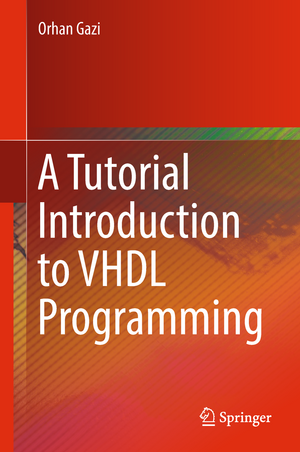A Tutorial Introduction to VHDL Programming
Autor Orhan Gazien Limba Engleză Hardback – 27 aug 2018
The book is divided into eight chapters, covering aspects ranging from the very basics of VHDL syntax and the module concept, to VHDL logic circuit implementations. In the first chapter, the entity and architecture parts of a VHDL program are explained in detail. The second chapter explains the implementations of combinational logic circuits in VHDL language, while the following chapters offer information on the simulation of VHDL programs and demonstrate how to define data types other than the standard ones available in VHDL libraries. In turn, the fifth chapter explains the implementation of clocked sequential logic circuits, and the sixth shows the implementation of registers and counter packages. The book’s last two chapters detail how components, functions and procedures, as well as floating-point numbers, are implemented in VHDL. The book offers extensive exercises at the end of each chapter, inviting readers to learn VHDL by doing it and writing good code.
| Toate formatele și edițiile | Preț | Express |
|---|---|---|
| Paperback (1) | 485.61 lei 6-8 săpt. | |
| Springer Nature Singapore – 19 ian 2019 | 485.61 lei 6-8 săpt. | |
| Hardback (1) | 588.37 lei 6-8 săpt. | |
| Springer Nature Singapore – 27 aug 2018 | 588.37 lei 6-8 săpt. |
Preț: 588.37 lei
Preț vechi: 692.19 lei
-15% Nou
Puncte Express: 883
Preț estimativ în valută:
112.60€ • 116.32$ • 93.71£
112.60€ • 116.32$ • 93.71£
Carte tipărită la comandă
Livrare economică 25 martie-08 aprilie
Preluare comenzi: 021 569.72.76
Specificații
ISBN-13: 9789811323089
ISBN-10: 9811323089
Pagini: 231
Ilustrații: VII, 251 p. 414 illus., 29 illus. in color.
Dimensiuni: 155 x 235 mm
Greutate: 0.54 kg
Ediția:1st ed. 2019
Editura: Springer Nature Singapore
Colecția Springer
Locul publicării:Singapore, Singapore
ISBN-10: 9811323089
Pagini: 231
Ilustrații: VII, 251 p. 414 illus., 29 illus. in color.
Dimensiuni: 155 x 235 mm
Greutate: 0.54 kg
Ediția:1st ed. 2019
Editura: Springer Nature Singapore
Colecția Springer
Locul publicării:Singapore, Singapore
Cuprins
Entity, Architecture and VHDL Operators.- Combinational Logic Circuit Design and Concurrent Coding in VHDL.- Simulation of VHDL Programs.- User Defined Data Types, Arrays and Attributes.- Sequential Circuit Implementation in VHDL.- VHDL Implementation of Logic Circuits Involving Registers and Counters.- Packages, Components, Functions and Procedures.- Fixed and Floating Point Numbers.
Notă biografică
Orhan Gazi is an Associate Professor at the Electronic and Communication Engineering Department, Cankaya University. He completed his BS, MS, and PhD degrees in Electrical and Electronics Engineering from Middle East Technical University, Ankara, Turkey, in 1996, 2001 and 2007, respectively.
His research areas involve signal processing, information theory, and forward error correction. More recently, he has begun studying polar channel codes and preparing publications in this area.
He has published several textbooks on Digital Signal Processing and Information Theory, as well as a monograph on Channel Coding.
His research areas involve signal processing, information theory, and forward error correction. More recently, he has begun studying polar channel codes and preparing publications in this area.
He has published several textbooks on Digital Signal Processing and Information Theory, as well as a monograph on Channel Coding.
Textul de pe ultima copertă
This book helps readers create good VHDL descriptions and simulate VHDL designs. It teaches VHDL using selected sample problems, which are solved step by step and with precise explanations, so that readers get a clear idea of what a good VHDL code should look like.
The book is divided into eight chapters, covering aspects ranging from the very basics of VHDL syntax and the module concept, to VHDL logic circuit implementations. In the first chapter, the entity and architecture parts of a VHDL program are explained in detail. The second chapter explains the implementations of combinational logic circuits in VHDL language, while the following chapters offer information on the simulation of VHDL programs and demonstrate how to define data types other than the standard onesavailable in VHDL libraries. In turn, the fifth chapter explains the implementation of clocked sequential logic circuits, and the sixth shows the implementation of registers and counter packages. The book’s last two chapters detail how components, functions and procedures, as well as floating-point numbers, are implemented in VHDL.
The book offers extensive exercises at the end of each chapter, inviting readers to learn VHDL by doing it and writing good code.
Caracteristici
Guides the reader to create good VHDL descriptions and to simulate VHDL designs Explains VHDL through solving selected sample problems Offers extensive exercises at the end of each chapter so that the reader is invited to learn VDHL by doing it and writing good code
